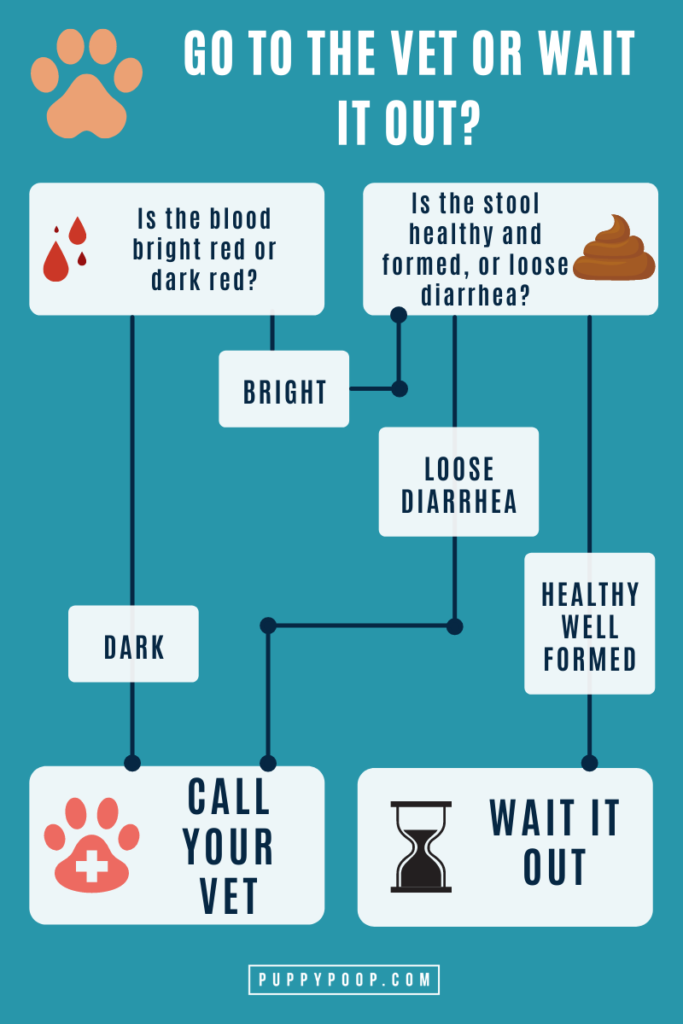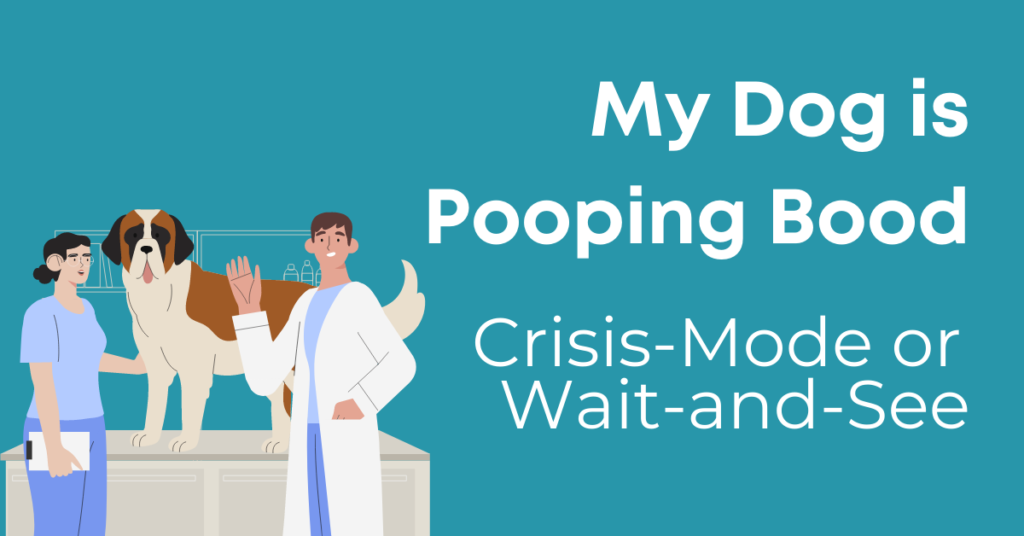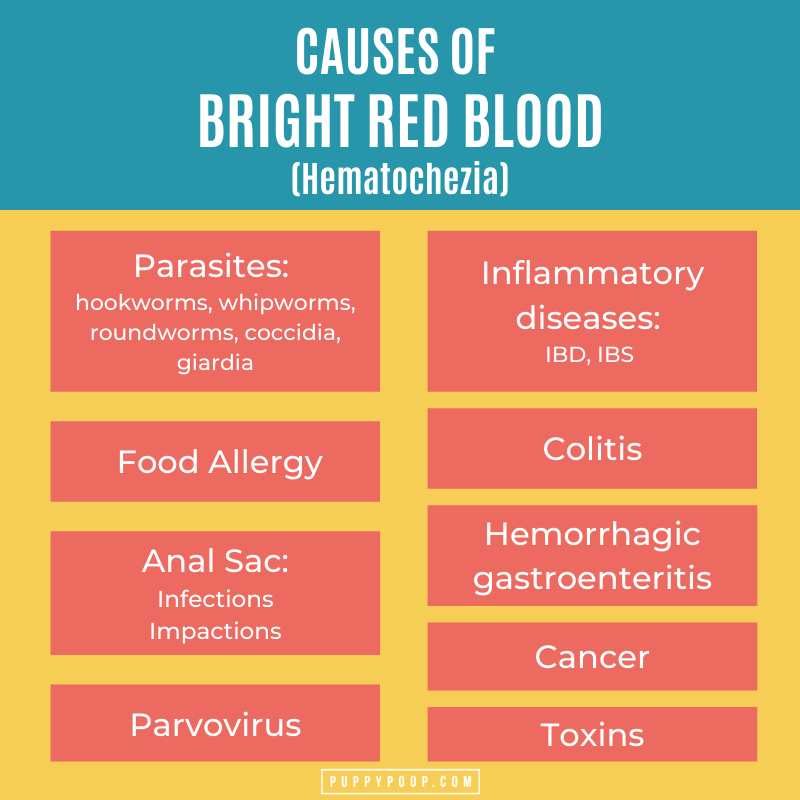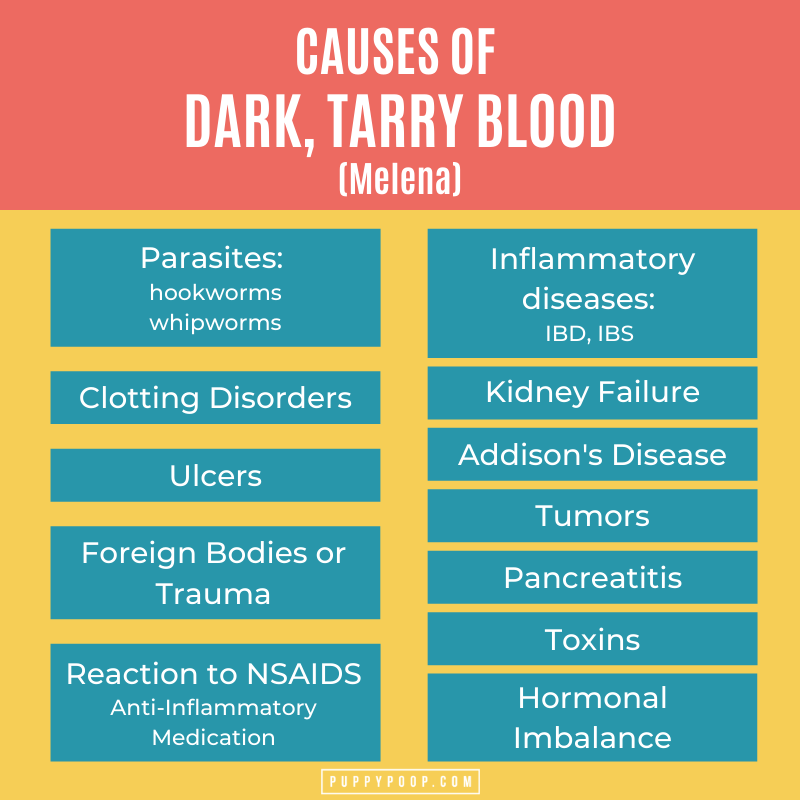You’re on a regular walk with your dog, and she stops to squat and poop. When you go to pick it up, you see red – literally. Is my dog pooping blood? Did she eat cranberries? What is going on? Your mind starts racing – is she bleeding inside? Is she OK? She seems normal and happy… what should I do?
As dog owners, we’ve become very familiar with what’s considered “normal” for our dog’s poop to look like. So when the alarm bells are sounding, something is definitely up. Good news – not all blood is a cause for the “code-red emergency vet” visit. Here are some tips for how to make the decision.

Step by Step: Go to the Vet or Wait it out?
Step 1: Is the blood bright red or dark red?
Why does this matter? Bright blood and dark blood are clues for where this blood came from along the digestive tract – clues that have very different implications.
Bright Blood
Bright blood, or if we’re being fancy, hematochezia, likely came from the large intestine or rectum. This type of blood can also come from the anus. The blood may be mixed in with the stool, or only on the surface.
You may be able to wait it out. Jump to Step 2.
Dark Blood
Dark blood, or melena, occurs in the upper-GI tract – the esophagus, stomach, or upper small intestine. It is dark because it’s had time to dwell and break down – this is why the color is so much darker. Dark blood can also appear tarry, thick, or jelly-like. If you’ve already picked up the poop, you may describe it as “sticky” or “tacky”.
You may need to make that urgent vet appt. Jump to step 4.
Step 2: Is the stool healthy and formed, or loose/diarrhea?
Healthy-looking, well-formed stool
Wait it out. Jump to step 3.
Loose/Diarrhea
You may need to make that urgent vet appt. Jump to step 4.
Step 3: Wait it out
While you’re waiting, review the tips below to get your dog’s digestive health back on track and save time, energy and frustration:
- Reduce potential triggers: Limit common stressors like new foods/treats, especially anything fatty, or environmental/situational causes.
- Soothe the gut: Try a 24-hour fast or temporarily feeding a bland diet of rice and lean beef or turkey (99% or 96% is ideal) along with a teaspoon to tablespoon of plain canned pumpkin.
- Take Photos: A dog poop picture is worth way more than a thousand words. Email the photo to your vet, and take photos of each bowel movement to track progress.
- Save the stool sample: Your veterinarian may want to perform tests on this stool sample, including fecal float to detect parasites, or giardia test. Learn more about worms in dogs and giardia in dogs.
- Re-trace your steps / routine: Have you changed any food, diet, or routine? Has your dog been in contact with a new environment, dog park, or dog? These clues can help you deduce what may have caused the episode.
- If bloody poop persists for 24 hours, it’s time for a vet visit – jump to step 4.
As facultative carnivores, dogs rely on protein as the main component of their diet. Unlike cats who are true carnivores, dog bodies can also process carbohydrates.
Step 4: Call the Veterinarian
What to do in an emergency:
- Use the preparation above to describe the situation.
- Use the flow chart to explain the symptoms.
When in doubt, use this script:
Today, my dog _____, who is a patient of Dr. _______, had a bowel movement with [bright/ dark] blood. The stool was a [hard / loose / diarrhea] consistency. Mucus was [present / absent]. This is the [x # of times] bloody stool she has had in ____ days. Other than bloody stool, I have observed [diet change, lethargy, loss of appetite, other symptoms, changes in routine]. She is on the following medications: _________________. I have a stool sample I can bring in for testing. What are the next steps?
What causes bloody poop in dogs?
Once we’ve decided what actions to take next, you are probably wondering, why is my dog pooping blood? Bloody stool can be caused by a variety of reasons, ranging from injury to parasites, acute to chronic diseases. Most likely, blood in your dog’s poop is the result of an injury to the lining of the digestive tract. This can be caused by swallowing a sharp object, an infection, an allergic reaction, or even an autoimmune condition. Some common causes of blood in poop are listed below.
While infection is the most common cause of bloody poop in dogs, another notable cause is the regular use of non-steroidal anti-inflammatory drugs (NSAIDs). NSAIDs can provide effective pain, inflammation, and fever relief for dogs. Some common NSAIDs are: Dermamaxx®, Doxidyl®, Previcox®, Galliprant®, Onisior®, and Rimadyl®, amongst others. Unfortunately, common side effects may include vomiting, decreased appetite, and diarrhea. Furthermore, NSAIDs can become trapped in the stomach and irritate its lining – causing irritation and distress. NSAIDs can also block the action of prostaglandins, which are responsible for controlling fever, pain, and inflammation as well as protecting the stomach and intestinal wall linings. With fewer prostaglandins, a dog’s digestive system is more susceptible to ulcers and other damage which causes bleeding and diarrhea. As always, if you notice any side effect occurring after beginning use of any medications, please consult your veterinarian.
There is no doubt that seeing blood in your dog’s poop can be alarming. However, the good news is, it’s not always a cause for an emergency vet visit. Always consult your veterinarian if you notice blood, or anything strange, in your dog’s stool for over 24 hours. We recommend using the free DIG Labs Health Check app to conveniently and accurately capture, monitor, and share any stool symptoms with your veterinarian.
Get the DIG Labs App
Download the free DIG Labs Digestive Health Tracker to get personalized insights and recommendations for your dog based on their stool.



